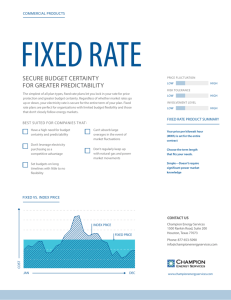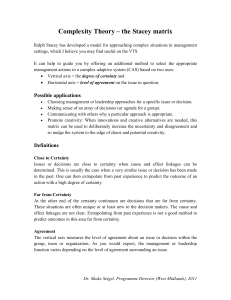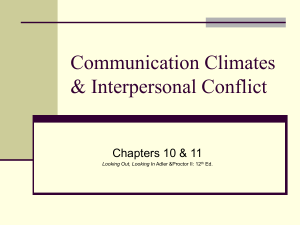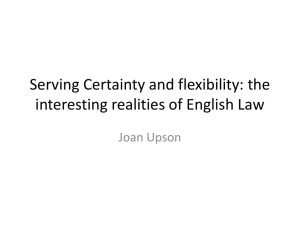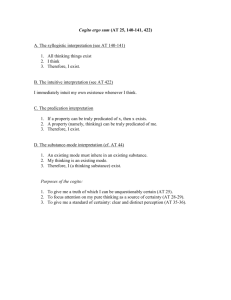Document 17866372
advertisement
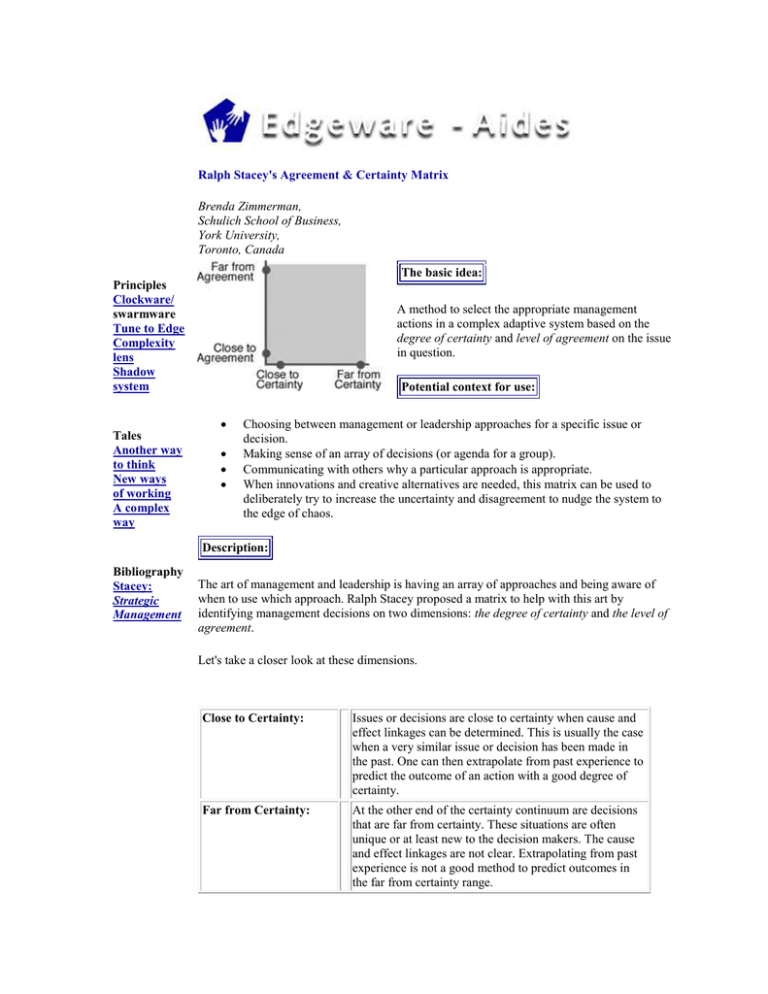
Ralph Stacey's Agreement & Certainty Matrix Brenda Zimmerman, Schulich School of Business, York University, Toronto, Canada The basic idea: Principles Clockware/ swarmware Tune to Edge Complexity lens Shadow system A method to select the appropriate management actions in a complex adaptive system based on the degree of certainty and level of agreement on the issue in question. Potential context for use: Tales Another way to think New ways of working A complex way Choosing between management or leadership approaches for a specific issue or decision. Making sense of an array of decisions (or agenda for a group). Communicating with others why a particular approach is appropriate. When innovations and creative alternatives are needed, this matrix can be used to deliberately try to increase the uncertainty and disagreement to nudge the system to the edge of chaos. Description: Bibliography Stacey: Strategic Management The art of management and leadership is having an array of approaches and being aware of when to use which approach. Ralph Stacey proposed a matrix to help with this art by identifying management decisions on two dimensions: the degree of certainty and the level of agreement. Let's take a closer look at these dimensions. Close to Certainty: Issues or decisions are close to certainty when cause and effect linkages can be determined. This is usually the case when a very similar issue or decision has been made in the past. One can then extrapolate from past experience to predict the outcome of an action with a good degree of certainty. Far from Certainty: At the other end of the certainty continuum are decisions that are far from certainty. These situations are often unique or at least new to the decision makers. The cause and effect linkages are not clear. Extrapolating from past experience is not a good method to predict outcomes in the far from certainty range. Agreement: The vertical axis measures the level of agreement about an issue or decision within the group, team or organization. As you would expect, the management or leadership function varies depending on the level of agreement surrounding an issue. The following pages will examine different zones within the matrix. They are: 1. 2. 3. 4. 5. Close to Agreement, Close to Certainty Far from Agreement, Close to Certainty Close to Agreement, Far from Certainty Anarchy: Far from Agreement, Far from Certainty The Edge of Chaos 1) Close To Agreement, Close To Certainty Much of the management literature and theory addresses the region on thematrix which is close to certainty and close to agreement. In this region, we use techniques which gather data from the past and use that to predict the future. We plan specific paths of action to achieve outcomes and monitor the actual behavior by comparing it against these plans. This is sound management practice for issues and decisions that fall in this area. The goal is to repeat what works to improve efficiency and effectiveness. 2) Far From Agreement, Close To Certainty Some issues have a great deal of certainty about how outcomes are created but high levels of disagreement about which outcomes are desirable. Neither plans nor shared mission are likely to work in this context. Instead, politics become more important. Coalition building, negotiation, and compromise are used to create the organization's agenda and direction. 3) Close To Agreement, Far From Certainty Some issues have a high level of agreement but not much certainty as to the cause and effect linkages to create the desired outcomes. In these cases, monitoring against a preset plan will not work. A strong sense of shared mission or vision may substitute for a plan in these cases. Comparisons are made not against plans but against the mission and vision for the organization. In this region, the goal is to head towards an agreed upon future state even though the specific paths cannot be predetermined. 4) Anarchy: Far From Agreement, Far From Certainty Situations where there are very high levels of uncertainty and disagreement, often result in a breakdown or anarchy. The traditional methods of planning, visioning, and negotiation are insufficient in these contexts. One personal strategy to deal with such contexts is avoidance avoiding the issues that are highly uncertain and where there is little disagreement. While this may be a protective strategy in the short run, it is disastrous in the long run. This is a region that organizations should avoid as much as possible. 5) The Edge of Chaos (The Zone of Complexity) There is a large area on this diagram which lies between the anarchy region and regions of the traditional management approaches. Stacey calls this large center region the zone of complexity - others call it the edge of chaos. In the zone of complexity the traditional management approaches are not very effective but it is the zone of high creativity, innovation, and breaking with the past to create new modes of operating. As a professor in a business school, I am aware that we spend much of our time teaching how to manage in areas (1), (2) and (3). In these regions, we can present models which extrapolate from past experience and thereby can be used to forecast the future. This is the hallmark of good science in the traditional mode. When we teach approaches, techniques and even merely a perspective in area (4) the models seem 'soft' and the lack of prediction seems problematic. We need to reinforce that managers and leaders of organizations need to have a diversity of approaches to deal with the diversity of contexts. Stacey's matrix honors what we already have learned but also urges us to move with more confidence into some of the areas which we understand intuitively but are hesitant to apply because they do not appear as 'solid.' Reflection: Before using this aide: Do you have diversity in the level of complexity (or the extent of agreement or certainty) in the issues or problems your organization faces? Do you have sufficient diversity in the approaches you take for these different contingencies? After using this aide: How can you adapt this approach to make it your own? Examples: A co-researcher and I were studying a non-profit organization in an action learning mode. We observed and worked along side the board during a full year of meetings. They were very keen on complexity science and its applications to their work. After a while, my co-researcher and I became increasingly concerned about the board's approach to issues. They seemed to complexify some very simple issues and drop some of the more challenging and fundamental issues facing the agency. Meanwhile the staff were getting increasingly frustrated with the board and began to over-simplify issues and seemed to want to avoid any creative suggestions from the board. At a board-staff retreat, we presented them with a simplified version of the Stacey matrix. We used only four categories of issues - simple, complicated and complex issues which were all 'manageable' to some extent and anarchy which was to be avoided. We divided the participants into five groups and gave them a number of sheets of plastic film which they could write on and post on the walls. We asked them to think through the issues and decisions of the past year and sort them into three categories - simple, complicated and complex. Each issue was written on a separate page. They were then asked to post them on a wall under the three headings - simple, complicated and complex. What we discovered was there was almost no disagreement about the issues and how they should be sorted. All of the groups came to the same (or very similar) conclusions. We then asked them to think about the management techniques or approaches they had used for each issue. After a while we heard laughter from several of the groups. They became aware of how they had used simple approaches for complex problems and vice versa. We added to this by reading excerpts from the transcripts from some of the meetings we had attended. The staff began to volunteer their insights into the board's behavior and their reaction to it. The staff commented that they could now see why the board was at times trying to push them into the zone of complexity. The board could see why the staff wanted to cut off discussion and generation of new ideas on some of the simpler issues. They also commented on how the matrix did not represent a rigid landscape rather that issues moved from one zone to another in part due to external conditions and in part due to the participants' perspectives on an issue. The result was an honoring of a diversity of approaches. They could see the value others added to the array of issues facing the organization. The next stage was to ask them to do the same exercise with the coming issues or issues that they were expecting to address in the coming year. Again the exercise showed remarkable overlap between the participants as to which category an issue belonged. But they also began to question their own quick consensus. Should this issue be as simple as they had suggested? Could they be missing an opportunity by not pushing it, at least for a while, into the zone of complexity? Their story is still unfolding, but it showed how the matrix was a useful aide in opening up discussion and creating opportunities for them to examine the management approaches they often took for granted. Facilitator's Tips: Present the matrix in a layered format as shown in the "Description" section above. This can be done with or without Stacey's words in the various regions. (For some groups, the matrix in the example above may be an easier way to introduce the matrix.) Ask participants to identify concrete examples from their workplace for each region. Have the participants discuss which approaches make sense for which region, and why. Lead a discussion of what factors would suggest an issue is more likely to be in the zone of complexity or one of the other regions? Look for issues of how many people or institutions are connected, the time frame between the 'cause' and potential effects, areas of higher turbulence or unpredictability etc.. Start with historical examples and then move into current or future issues. After the participants have worked with the matrix in a real context, have them reconvene and reflect on how they used it. Did they adapt it, change it for their own context? Attachments: Dr. Stephen Larned is the Vice President of Medical Affairs for the Maine Medical Center. He has found the Stacey matrix very helpful in his work. He began by using the matrix to make sense of past events. Then he used to help with current events. Now he has revised the matrix to make it work best for him to help with current and future issues. His revision is a diagonal line through the matrix on which he has placed seven different management interventions. Each of the seven approaches fits with the degree of certainty and agreement present in the context. The role of the leader shifts quite dramatically as you move along the diagonal. The matrix shown below is Larned's adaptation. The chart after the matrix are seven actual or hypothetical cases that Larned has used to depict each approach. Larned's value added in this is two-fold. First he demonstrates the value of 'owning' your own models. Second he shows specific and concrete examples of how his management and leadership style need to vary by context. Moving from Agreement & Certainty Modified from Ralph D. Stacey: "Complexity and Creativity in Organizations" Changing Management Approaches in Moving From Agreement & Certainty Possible Approach 1. Direct Description Example Direct workers to Employer asks an employee complete a task to arrange a luncheon, clean or tasks. the warehouse, etc. Modify work 2. Change Work Processes processes to facilitate selforganization, self-direction, etc. Fork lift company with newly computerized product. Managers connected all of service staff through CompuServe. A summary of their E-mail exchanges became the new service manual. Comments Left lower corner of the Stacey diagram. Highly structured and directive. Does not anticipate emergent outcome. Sufficient control of variables to allow planned change in systems, organization, or information flow, etc. Leaders took a specific step. Intended or unintended emergent outcome. 3. Modify Structure Modify diversity, Maine Medical Center information, and attempts to change connections. workgroups (Chiefs, clinical groups, others), meeting structures, distribution of information. Similar to above, less focused. Specific steps taken to attempt to affect diversity, information, and connections, in hopes of beneficial emergent outcomes. 4. Convene & Intervene Bring representatives of various CASs together to Primary step is to convene representatives of involved complex adaptive systems. Louisville integrated "Oncology Program" problem. Maine Hospice program problem. 5. Convene 6. Examine, Describe Patterns facilitate selforganization and emergence. Use process tools to confront inherent parodoxes and to seek change through leveraging Morgan's 15% opportunity. Compare approaches with and without goals. Secondary step is structured, planned "intervention" that actively attempts to "move to a new attractor." (Per G. Morgan) Bring MMC/UNE representatives of (Allopathic/Osteopathic various complex Education) adaptive systems together in an attempt to facilitate selforganization and emergence. Compare active convening with observation of entities coming together. Insufficient Observe The economy or the stock interactions market. between complex adaptive systems that are beyond the leader's ability to affect or convene. The task here is to understand. Systems are sufficiently large or removed to preclude any intervention. Youth, health, markets, life 7. Seek Patterns Scanning "chaotic and forms, weather, global disorganized" thermal drift, etc. systems for emerging organizations and patterns. involvement or direct control to allow formal intervention. Action limited to convening in hopes that interaction and change will emerge. Less structured intervention than above example. Assumption here is that object of study is approaching high dimensional chaos. Task is to identify emerging patterns that might suggest an emerging level of organization. Modified from Ralph D. Stacey: "Complexity and Creativity in Organizations" Next | Previous | Return to Contents List Copyright © 2001, Brenda J. Zimmerman. Schulich School of Business, York University, Toronto, Canada. Permission to copy for educational purposes only.
